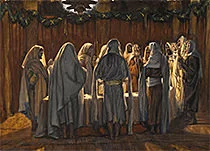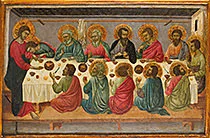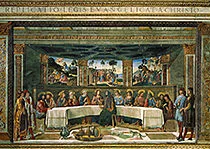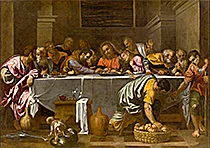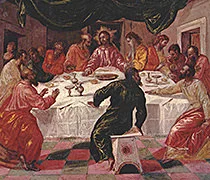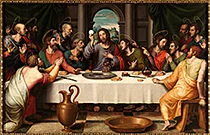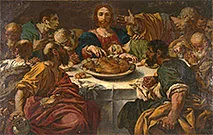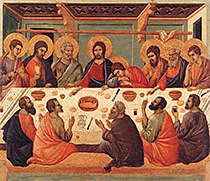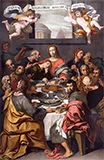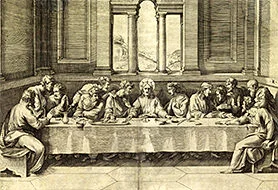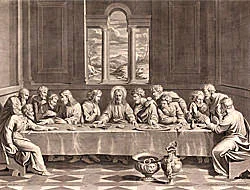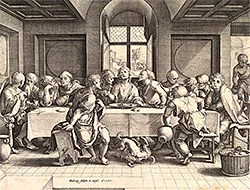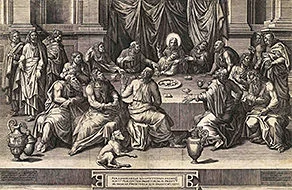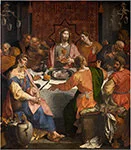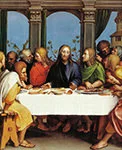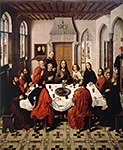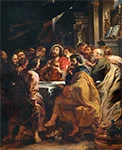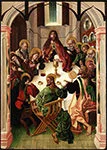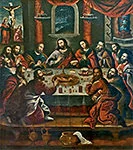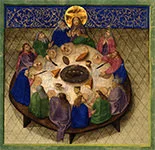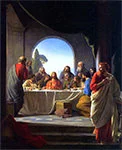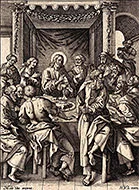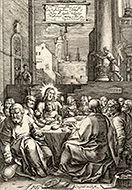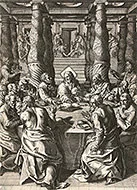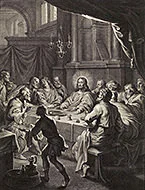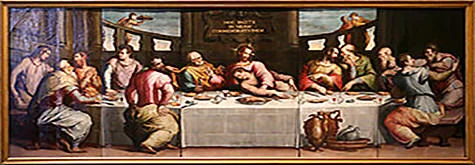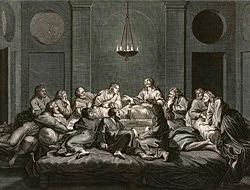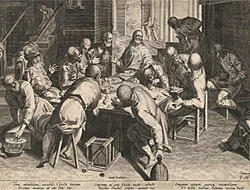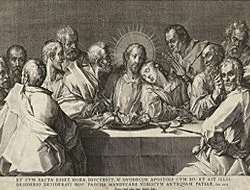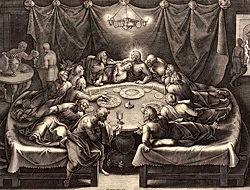The Art World Commemorates Peter
— Album 9 of 17 Photo Albums —
Warren Camp’s presentation of 550 famous “Peter” works of art includes historic paintings, frescoes, stained glass, etchings, sculptures, engravings, and other artwork monuments. They come from the Gothic (1100–1400), High Renaissance, Baroque, Rococo, Neoclassical, and Romantic (1800s) eras.
All are popular works, designed and created by celebrated artists, many of whom you’ll likely recognize, including Rembrandt, Raphael, Michelangelo, El Greco, Da Vinci, Masaccio, Huret, Galle, Tissot, Botticelli, Dürer, Rubens, and many more. They’ll bring back recollections of your “Art History 101” classes, using Janson’s History of Art textbook.
Whether depicting “Cephas,” “Petrus,” “Simon,” “Simeon,” “Simon Bar-Jonah,” “Simon Peter,” “The Rock,” “Peter,” “Apostle Peter,” or “Saint Peter,” the enlarged images of this acclaimed Bible figure come with factual and enlightening details: the artist’s bio; when each work was created; where it can be seen; applicable Bible passages; background and highlights of each work; and photo sources with copyright notices.
To appreciate the impact that Peter had on numerous art-world masters, be sure to click each thumbnail to enlarge it.
• These photo albums complement the Bible-study commentaries Warren has written for “1st and 2nd Peter,” found here.
…
Album 1 (Peter, alone) | Album 2 | Album 3 | Album 4 | Album 5
Album 6 | Album 7 | Album 8 | Album 9 | Album 10 | Album 11
Album 12 | Album 13 | Album 14 | Album 15 | Album 16 | Album 17
Album topics are shown at the [ ⇓ bottom ⇓ ] of each page.
Jesus’ Last Supper — Part 1 of 4
136 “Last Supper” Masterpieces in Four Photo Albums
Includes Rosselli, El Greco, Rubens, Duccio, Bloch, Nelli, Goltzius, Tissot, Van Luyck, Vasari, Wierix, and more
Slide 28
Click to enlarge.
Lorenzo Monaco, 1394–1395, altarpiece painting on poplar
See more “Last Supper” masterpieces in Warren Camp’s Album 10, Album 11, and Album 12.
- 1. “The Last Supper,” watercolor over graphite on paper, painted by James Tissot, 1886–1894
[ James Tissot (French, 1836–1902): “The Last Supper (La Cène légale),” 1886–1894. Brooklyn Museum, purchased by public subscription, 00.159.220 (Photo: Brooklyn Museum, 00.159.220_PS1.jpg). Be sure to see Tissot’s “Life of Christ” collection of 124 watercolors selected from a set of 350 that depict detailed New Testament scenes.]
The Life of Christ James Tissot painted in Paris alongside Claude Monet and Edouard Manet, often painting fashionable women of Paris. But, in 1885, he experienced a renewal of his faith and spent the rest of his life painting biblical scenes. Learn more about Tissot’s “The Life of Christ” exhibition.
The Ideal “Last Supper” Opener Today we find three major scenes shown in Last Supper depictions: (1) Jesus announcing his upcoming betrayal; (2) the sharing of the communion elements of bread and wine; and (3) Jesus washing his disciples’ feet [highlighted in our Album 8]. In Tissot’s rendition, the first Last Supper scene is about to begin. Mark tells us in his gospel account:, “when evening came, Jesus arrived with the Twelve” (Mark 14:17).
The apostles had entered the house of a certain man in the city; it was a large upstairs room, furnished and ready (v. 15) for Jesus and the Twelve to share the Passover feast on the first day of the Festival of Unleavened Bread. Not yet seated, all stand dressed in traveling clothes while holding their staffs. Tissot added garland decorations to this upper room. We learn from Scriptures that, during this supper, Jesus revealed that he’d be betrayed by one of his apostles, many of whom asked worriedly, “Surely you don’t mean me, Lord?” (v. 19).
… Height: 8 9/16 in. (21.7 cm), width: 12 1/16 in. (30.6 cm)
… Photo source, license, attribution, and museum details: Brooklyn Museum of Art; purchased by public subscription
… The artist’s short biography; his other works of art
Return to “Peter Masterpieces” album’s opening page or to the top of this page or open the next album. - 2. “The Last Supper,” tempera and gold on wood, painted by Ugolino da Siena (Ugolino di Nerio), c. 1325–1330
The Last Supper “Ugolino da Siena was the most original and accomplished follower of Duccio di Buoninsegna, the greatest Sienese painter of the fourteenth century. Among Ugolino’s most important commissions was the multi-panel altarpiece for the high altar of Santa Croce, the Franciscan church in Florence. This painting of ‘The Last Supper’ formed part of the predella (the lowermost horizontal component) of that now-dismembered altarpiece.
In this scene, the young apostle, John, rests his head on the shoulder of Christ. “Jesus, at the far left, informs his disciples that one of them will betray him, a prophecy fulfilled by Judas, who appears without a halo at Christ’s right. Ugolino’s exploration of spatial perspective is evident in details such as the coffered ceiling and the table settings.”[1]
The Last Supper was the final meal that Jesus shared with his apostles in Jerusalem before his crucifixion. The first epistle that Paul the apostle wrote to the Corinthian church body contains the earliest known mention of the Last Supper: For I received from the Lord what I also passed on to you: The Lord Jesus, on the night he was betrayed, took bread, and when he had given thanks, he broke it and said, “This is my body, which is for you; do this in remembrance of me.” In the same way, after supper he took the cup, saying, “This cup is the new covenant in my blood; do this, whenever you drink it, in remembrance of me.” For whenever you eat this bread and drink this cup, you proclaim the Lord’s death until he comes (1 Cor. 11:23–26 NIV).”
… (framed) Height: 15 in. (38.1 cm), width: 22 1/4 in. (56.5 cm)
… Photo source, license, attribution, museum details, and image enlargement: public domain via The Met; Robert Lehman Collection, 1975
… The artist’s short biography; his other works of art
Return to “Peter Masterpieces” album’s opening page or to the top of this page or open the next album. - 3. “The Last Supper,” fresco painting by Cosimo Rosselli, 1481–1482
“The Last Supper” is “a fresco by the Italian Renaissance painter Cosimo Rosselli (helped by Biagio d’Antonio). Created 1481–1482, it is located in the Sistine Chapel in Rome. The scene is part of the ‘Stories of Jesus’ cycle. Like the others it shows more than one episode at the same time. This supper is set in a semi-circular apse, with a horseshoe-shaped table that has Jesus sitting center, the apostles at his sides. Judas Iscariot, as usual, appears on the other side of Jesus, from behind; the fighting cat and dog are elements that further stress this negative connotation. We see the moment immediately after Jesus’ annunciation that one of his twelve apostles would betray him. His hearers’ reactions include touching their chests or muttering to each other.
“Within the three windows behind the table are three scenes of the Passion [see details of each scene]: (1) ‘Jesus’ Prayer at Gethsemane’ (32 paintings are featured in our Album 13); (2) ‘Arrest of Jesus’ (see 36 masterpieces in Album 14); and (3) ‘The Crucifixion.’”[1] “The highlighted chalice standing by itself on the table, in front of Christ, emphasizes the institution of the sacrament of the Eucharist: a symbol of the new covenant between God and mankind.”[2]
The story of the Last Supper, which happened on the night before Christ’s crucifixion, is found in these five New Testament passages: (Matthew 26:17–30; Mark 14:12–26; Luke 22:7–30; John 13:18–30; and 1 Corinthians 11:23–26). To appreciate the essence of the Last Supper account, watch this highly acclaimed 2020 movie titled “The Gospel of John.”
… Height: 11.4 ft. (349 cm), width: 18.7 ft. (570 cm)
… Photo source, license, attribution, museum details, and image enlargement: Cosimo Rosselli, public domain, via Wikimedia Commons
… The artist’s short biography; his other works of art
Return to “Peter Masterpieces” album’s opening page or to the top of this page or open the next album. - 4. “The Last Supper,” oil on canvas, painted by Agostino Carracci, 1593–1594
“Together with his brother Annibale and his cousin Ludovico, Agostino Carracci founded the so-called Accademia degli Incamminati in Bologna. Its teachings promoted the study of nature and the work of the great Renaissance masters. While the coloring and handling of this canvas are influenced by Tintoretto, the monumental figures of the apostles and the architectural setting look to Raphael. The result was to create a new model of perfection that combined the styles of the Venetian and Roman schools, previously considered to be opposed to one another.[1]
Herein, the young apostle, John, rests his hand and head on the left shoulder of Jesus who sits in the center of this painting. On Jesus’ other side is Peter who looks directly into the Lord’s eyes. Also of note is Carracci’s placement of Judas Iscariot, sitting on a stool at the opposite side of the table from Jesus, bending backwards to pick up a loaf of bread. It’s common with depictions of the Last Supper from this period that the artist seats the diners on one side of the table, so that none of them has his back to the viewer.
The Last Supper was the final meal that Jesus shared with his apostles in Jerusalem before his crucifixion. Paul’s first epistle, which he wrote to the Corinthian church body, contains the earliest known mention of the Last Supper. Read this very personal passage in 1 Cor. 11:23–26. To appreciate the essence of the Last Supper account, watch this highly acclaimed 2020 movie titled “The Gospel of John.”
… Height: 5 ft. 8 in. (172 cm), width: 7 ft. 9 in. (237 cm)
… Photo source, license, attribution, museum details, and image enlargement: public domain via Museo Nacional del Prado
… The artist’s short biography; his other works of art
Return to “Peter Masterpieces” album’s opening page or to the top of this page or open the next album. - 5. “The Last Supper,” oil on panel, painted by El Greco, c. 1568
“The Last Supper” has been a favorite subject in Italian art, beginning around 1400, especially in monasteries. Artwork typically portrayed reactions of the disciples to Christ’s betrayal announcement. It was the final meal that Jesus shared with his apostles in Jerusalem before his crucifixion. Paul’s first epistle, which he wrote to the Corinthian church body, contains the earliest known mention of the Last Supper. Read this very personal passage in 1 Cor. 11:23–26.
“Betrayal” scene… “This is the moment when Christ reveals that one of his disciples will betray him. As we closely examine the disciples in El Greco’s oil-on-panel painting, their responses are of interest. The two disciples on either side of Christ are Peter to the left and John to the right. Both appear to be asking, “Could it be me, Lord?” Their looks are almost introspective, searching their hearts and minds for signs that they might be the one who’ll betray Christ.
“As we sweep around the table, most of the disciples seem to have the same attitude, with heads down. A few look shocked with their hands raised, staring at Christ, except for Judas Iscariot, in stark contrast to the other disciples. Painted in a dark oppressive color, he has his back to us. Additionally, Judas appears untouched by the light that touches all the others, as shown on their faces or heads. And, none of the disciples has a traditional halo; Christ, however, has an exclusive ‘cruciate’ one that resembles the shape of the cross.” Watch an in-depth review that highlights this painting’s unique attributes.
… Height: 16.9 in. (43 cm), width: 20.4 in. (52 cm)
… Photo source, license, attribution, museum details, and image enlargement: El Greco, public domain, via Wikimedia Commons
… The artist’s short biography; his other works of art
Return to “Peter Masterpieces” album’s opening page or to the top of this page or open the next album. - 6. “The Last Supper,” oil on panel by Juan de Juanes, 1555–1562
“The Last Supper” was painted by Juan de Juanes (1503–1579) “for the base of the main altarpiece of Church of San Esteban, Valencia, Spain. Inspired by Leonardo, both in the definition of the space and in the eloquent expressiveness of the apostles, it also shows De Juanes’ close relationship with Raphael. In keeping with traditional iconography in Spain, he focused the scene on Jesus, serene and triumphant at the moment of consecrating the Sacred Host. The chalice that appears in the center of the table reproduces the one kept in Valencia Cathedral, considered to be the one used by Christ at the Last Supper. The jug and basin in the foreground allude to the foot washing that took place before the supper. All of the apostles bear halos with their names except Judas Iscariot, whose name appears on the bench where he sits. His beard and hair are red and, in keeping with tradition, he wears yellow — the color that symbolizes envy — and hides a bag of money from his companions.”[1]
Herein we see Christ about to reveal which of his disciples will betray him. Looking closely at the disciples’ gestures in De Juanes’ painting, their responses are filled with feeling. The two disciples at Christ’s side are Peter [left] and John [right], each wondering, “Could it be me, Lord?” Their facial expressions show them fearing that they might be the one who’ll betray Christ. In John’s gospel (13:18–30), “Jesus answered, ‘It is the one to whom I will give this piece of bread when I have dipped it in the dish.’ Then, dipping the piece of bread, he gave it to Judas, the son of Simon Iscariot. As soon as Judas took the bread, Satan entered into him” (vv. 26–27).
… Height: 45.7 in. (116 cm), width: 75.2 in. (191 cm)
… Photo source, license, attribution, museum details, and image enlargement: Museo del Prado
… The artist’s short biography; his other works of art
Return to “Peter Masterpieces” album’s opening page or to the top of this page or open the next album. - 7. “The Last Supper,” drawing/painting on paper then canvas, by Bartolomeo Schedoni, 1578–1615
“The Last Supper” is “the last meal Jesus ate with His disciples before His betrayal and arrest. The Last Supper is recorded in the synoptic gospels (Matthew 26:17–30; Mark 14:12–26; Luke 22:7–30). More than Jesus’ last meal, it was also a Passover meal. One of the important moments of the Last Supper is Jesus’ command to remember what He was about to do on behalf of all mankind: shed His blood on the cross, paying our sin debt (Luke 22:19–21). In addition to predicting His suffering and death for our salvation (vv. 15–16), Jesus also used the Last Supper to give the Passover new meaning, institute the New Covenant, establish an ordinance for the church, and foretell Peter’s denial of Him (v. 34) and Judas’ betrayal (Matt. 26:21–24).”[1]
Here, in Bartolomeo Schedoni’s masterpiece, we see Christ preparing to reveal which of his disciples will betray him. Looking closely at the disciples’ gestures in the artist’s drawing/painting, their responses are filled with feeling. The two disciples on either side of Christ are Peter to our left and John to our right, both with their heads facing downward. The facial expression of each apostle at the table shows their fear of being the one who’ll betray Christ. In John’s gospel (John 13:18–30), we learn that “Jesus answered, ‘It is the one to whom I will give this piece of bread when I have dipped it in the dish.’ Then, dipping the piece of bread, he gave it to Judas, the son of Simon Iscariot. As soon as Judas took the bread, Satan entered into him” (vv. 26–27). To appreciate the essence of the Last Supper account, watch this highly acclaimed 2020 movie titled “The Gospel of John.”
… Height: 9 5/16 in. (23.7 cm), width: 14 1/2 in. (36.8 cm)
… Photo source, license, attribution, museum details, and image enlargement: The Met; the Rogers Fund, 1961
… The artist’s short biography; his other works of art
Return to “Peter Masterpieces” album’s opening page or to the top of this page or open the next album. - 8. “The Last Supper,” tempera on panel, painted by Duccio di Buoninsegna, 1308–1311
The Last Supper by Duccio “is one of the twenty-six narrative scenes from the ‘Stories of the Passion’ on the reverse side of the Maestà. (See Duccio’s other Maestà [Majesty] paintings in our Album 15. And to see many more of Duccio’s Maestà creations that feature Peter, open Warren Camp’s Albums #2, 4, 8, 9, 13, 14, and 15.) It is situated in the bottom row, left side, below the ‘Washing of the Feet’ scene; see this graphic of all the Maestà scenes.
Duccio’s “The Last Supper” is dominated by the central figure of Jesus who, to the astonishment of the onlookers, is offering bread to Judas Iscariot. An unusual experiment with space has been made with John, whose position is traditional: The head of the favorite disciple is painted in front of the figure of Christ; his halo is behind Christ’s shoulders. Wooden bowls, knives, a decorated jug, and a meat dish with the paschal lamb, are set on the table, which is covered with a simple tablecloth woven in a small diamond pattern.”[1]
The “Eucharist” scene… While the first of three scenes of Western-Medieval “Last Supper” art masterpieces is the “Betrayal” scene in which we find the dramatic, dynamic moment when Jesus announced his upcoming betrayal, this Duccio altarpiece painting depicts the second scene: the “Eucharist,” also known as Holy Communion and the Lord’s Supper. Herein, the apostles have begun to partake of the bread, wine, and Passover lamb.
Here’s Apostle Paul’s Holy Communion passage that he’d written to members of the church body in Corinth: 1 Corinthians 11:23–26.
… Height: 19.6 in. (50 cm), width: 20.8 in. (53 cm)
… Photo source, license, attribution, museum details, and image enlargement: Duccio di Buoninsegna, public domain, via Wikimedia Commons
… The artist’s short biography; his other works of art
Return to “Peter Masterpieces” album’s opening page or to the top of this page or open the next album.
- 9. “The Last Supper,” oil on canvas, painted by Daniele Crespi, 1629–1630
Daniele Crespi’s “The Last Supper” is a painted depiction of the last meal that Jesus Christ had eaten with his disciples. “This artist was certainly influenced by ‘The Last Supper’ painting by Gaudenzio Ferrari for the church of La Passione in Milan. However, concerning the grouping of the apostles’ heads and the vitality displayed by the figures, Crespi’s painting also draws on the version executed by Leonardo, in Santa Maria delle Grazie.”[1]
“A study of the Lord’s Supper is a soul-stirring experience because of the depth of meaning it contains. It was during the age-old celebration of the Passover on the eve of His death that Jesus instituted a significant new fellowship meal — the Eucharist — that we observe today. It’s an integral part of Christian worship, causing us to remember our Lord’s death and resurrection and to look for His glorious return in the future.
“During the Last Supper — a Passover celebration — Jesus took a loaf of bread and gave thanks to God. As He broke it and gave it to His disciples, saying, “‘This is my body given for you; do this in remembrance of me.’ In the same way, after the supper he took the cup, saying, ‘This cup is the new covenant in my blood, which is poured out for you’” (Luke 22:19–21). He concluded the feast by singing a hymn (Matthew 26:30), and they went out into the night to the Mount of Olives where, as predicted, Jesus was betrayed by Judas. The following day Jesus was crucified.”[2] Here’s Apostle Paul’s Holy Communion passage that he’d written to members of the church body in Corinth: 1 Corinthians 11:23–26.
… Height: 10.9 ft. (335 cm), width: 7.2 ft. (220 cm)
… Photo source, license, attribution, museum details, and image enlargement: Pinacoteca di Brera, Milan, Italy
… The artist’s short biography; his other works of art
Return to “Peter Masterpieces” album’s opening page or to the top of this page or open the next album. - 10. “The Last Supper,” oil on canvas, painted by Florentine nun, Plautilla Nelli, 1550s
As Smithsonian Magazine reports, “Around 1568, Florentine nun Plautilla Nelli — a self-taught painter who ran an all-woman artists’ workshop out of her convent — embarked on her most ambitious project yet: a monumental Last Supper scene featuring life-size depictions of Jesus and the twelve apostles.”[1] See a number of outstanding detail photos of this restored Renaissance artwork on Smithsonian Magazine.
In Nelli’s scene, young apostle John rests his head on the left shoulder of Christ, centered, who informs his disciples that one of them will betray him. This was a prophecy fulfilled by Judas who sits across from Christ and is about to accept in his right hand a piece of bread that Jesus hands him (see detail).
The Last Supper was the final meal that Jesus shared with his apostles in Jerusalem before his crucifixion. Paul’s first epistle, which he wrote to the Corinthian church body, contains the earliest known mention of the Last Supper in the text of 1 Cor. 11:23–26, shown below. And to appreciate the essence of the Last Supper account, watch this highly acclaimed 2020 movie titled “The Gospel of John.”
The biblical account of the Last Supper, which happened the night before Christ’s crucifixion, is found in these five New Testament passages: (Matthew 26:17–30; Mark 14:12–26; Luke 22:7–30; John 13:18–30; and 1 Cor. 11:23–26).
… Height: 6.6 ft. (200 cm), width: 23 ft. (700 cm)
… Photo source, license, attribution, museum details, and image enlargement: Plautilla Nelli, public domain, via Wikimedia Commons
… The artist’s short biography; her other works of art
Return to “Peter Masterpieces” album’s opening page or to the top of this page or open the next album. - 11. “The Last Supper,” oil and gold on panel, painted by Central German Master, c. 1450–1470
The unnamed Central German Master who painted this panel appears to be one of the first artists to depict “The Last Supper” as having been served on a round table. As you’ll see in Warren Camp’s four photo albums featuring 132 Last Supper masterpieces, there are few round tables presented. “This painting shows Christ and his twelve disciples seated at a round table for the Last Supper. Christ raises his hand to consecrate the items before them: a chalice of wine and a loaf of bread partially sliced. Biblical accounts make it possible to identify some of the disciples, including the youthful, curly haired John, who rests his head on Christ’s bosom, and the traitorous Judas, the figure in yellow who furrows his brow.”[1]
The “Eucharist” scene of the Last Supper… While the first of three scenes of Western-Medieval “Last Supper” art masterpieces is the “Betrayal” scene in which we find the dramatic, dynamic moment when Jesus announced his upcoming betrayal, this Duccio altarpiece painting depicts the second scene: the “Eucharist,” also known as Holy Communion and the Lord’s Supper. Herein, the apostles have begun to partake of the bread, wine, and Passover lamb.
The story of the Last Supper, which happened on the night before Christ’s crucifixion, is found in these five New Testament passages: Matthew 26:17–30; Mark 14:12–26; Luke 22:7–30; John 13:18–30; and 1 Corinthians 11:23–26, which is Apostle Paul’s Holy Communion passage that he’d written to members of the church body in Corinth.
… Height: 44 1/2 in. (113 cm), width: 24 1/2 in. (62.2 cm)
… Photo source, license, attribution, museum details, and image enlargement: The Barnes Foundation; Philadelphia, PA
Return to “Peter Masterpieces” album’s opening page or to the top of this page or open the next album. - 12. “The Last Supper,” engraved on paper by Marco Dente de Ravenna, undated
“The Last Supper” This Marco Dente da Ravenna engraving on paper copied a like-kind engraving by Marcantonio Raimondi (1515–1516), as the “R” that was engraved on the right wall denotes. Incidentally, Raimondi had copied a like-kind presentation by Raphael.
In this “betrayal scene,” all of the Twelve are at the dining table with Jesus at the center. Typically, young apostle John sits to the right of Christ while Peter is to the viewer’s left. Jesus has just informed his disciples that one of them will betray him, a prophecy fulfilled by Judas who the artist doesn’t intentionally identify… See hundreds more Last Supper artwork varieties from Rijksmuseum Amsterdam in addition to its numerous Last Supper engraved prints.
What happened in the upper room? “The events that occurred in the ‘upper room,’ also known as the ‘Cenacle,’ are described in Matthew 26:1–29, Mark 14:12–25, Luke 22:7–20, and John 13:1–38. During these last hours that Jesus spent with His beloved friends, He ate with them, instituted the New Covenant in His blood, gave them last-minute instructions and encouragement, and prayed His ‘high priestly prayer’ over them. Then He went out to face the sorrow, betrayal, rejection, and death for which He had come into the world.”[1]
An excellent video — “Apostle Peter and the Last Supper” — portrays Peter in jail, telling his story of Jesus to a young Roman guard; it includes a very detailed account of the Last Supper, which delivers a powerful “faith” message.
… Height: 10.8 in. (27.5 cm), width: 17.1 in. (43.4 cm)
… Photo source, license, attribution, museum details, and image enlargement: National Galleries Scotland
… The artist’s short biography; his other works of art
Return to “Peter Masterpieces” album’s opening page or to the top of this page or open the next album.
- 13. “The Last Supper,” engraved on paper by an anonymous artist, 1673–1738, after Raphael
This anonymous artist’s “Last Supper” engraving is similar to Marco Dente’s engraving [see previous slide]. Interestingly, this artist transposed the traditional appearances of the apostles John and Peter. Herein, young John is at Christ’s right shoulder while Peter is at his left. The Latin footer text translation: “It is the bread of God who descends from heaven and gives the way to the world… John 6.”
The “betrayal scene. . .” All Twelve are at the dining table with Jesus who sits at its center. Following Jesus’ revelation that one of them would betray him that night, Peter and John look directly to the Lord with their hand on their heart, seeming to wonder, “Could it be me, Lord?” Their facial expressions show them fearing that they might be the one who’ll betray Christ. In John’s gospel (13:18–30), “Jesus answered, ‘It is the one to whom I will give this piece of bread when I have dipped it in the dish.’ Then, dipping the piece of bread, he gave it to Judas, the son of Simon Iscariot. As soon as Judas took the bread, Satan entered into him” (vv. 26–27).
The events that occurred in the ‘upper room’ (aka ‘Cenacle’) are described in Matthew 26:1–29, Mark 14:12–25, Luke 22:7–20, and John 13:1–38. “During these last hours that Jesus spent with His beloved friends, He ate with them, instituted the New Covenant in His blood, gave them last-minute instructions and encouragement, and prayed His ‘high priestly prayer’ over them. Then He went out to face the sorrow, betrayal, rejection, and death for which He had come into the world.”[2]
… Height: 19 2/3 in. (49.9 cm), width: 25 1/8 in. (64 cm)
… Photo source, license, attribution, museum details, and image enlargement: Rijksmuseum Amsterdam
Return to “Peter Masterpieces” album’s opening page or to the top of this page or open the next album. - 14. “The Last Supper,” engraved by Hendrick Goltzius, 1585, after Pieter Coecke van Aelst
“The Last Supper” Similar to the engravings on the previous two slides [12 and 13], Hendrick Goltzius copied a like-kind Last Supper painting shown on Album 10; it was one that Pieter Coecke van Aelst created initially. Interestingly, Goltzius also transposed the traditional appearances of the apostles John and Peter. Herein, young John is at Christ’s right shoulder while Peter is at his left. The engraver put Judas, sitting with his bag of coins on an unsteady bench, opposite Christ. Sitting at the dinner table in an upper room, all twelve apostles wear puzzled facial expressions, each wondering if he’d be the one who’d betray Christ later that evening.
The importance of the Lord’s Last Supper? “A study of the Lord’s Supper is a soul-stirring experience because of the depth of meaning it contains. It was during the age-old celebration of the Passover on the eve of His death that Jesus instituted a significant new fellowship meal that we observe today. It’s an integral part of Christian worship. It causes us to remember our Lord’s death and resurrection and to look for His glorious return in the future.”[1]
What happened in the Cenacle? “The events that occurred in the ‘upper room,’ also known as the ‘Cenacle,’ are described in Matthew 26:1–29, Mark 14:12–25, Luke 22:7–20, and John 13:1–38. During these last hours that Jesus spent with His beloved friends, He ate with them, instituted the New Covenant in His blood, gave them last-minute instructions and encouragement, and prayed His ‘high priestly prayer’ over them. Then He went out to face the sorrow, betrayal, rejection, and death for which He had come into the world.”[2]
… Height: 10 9/16 in. (26.8 cm), width: 14 1/8 in. (35.8 cm)
… Photo source, license, attribution, museum details, and image enlargement: The Met; The Elisha Whittelsey Collection, The Elisha Whittelsey Fund, 1951
… The artist’s short biography; his other works of art… See hundreds more Last Supper artwork varieties and numerous engraved prints.
Return to “Peter Masterpieces” album’s opening page or to the top of this page or open the next album.
- 15. “The Last Supper,” engraving on paper, by Giorgio Ghisi, 1551, after Lambert Lombard
The Last Supper This fourth like-kind Last Supper engraving is by Giorgio Ghisi, who presents in the upper room setting a sometimes-included dog and more individuals inside the Cenacle than the usual twelve disciples who traditionally sit around the table with Jesus at its center. This work was created after a painting by Lambert Lombard (not located), suggesting Lombard’s close familiarity with Italian Renaissance art, especially with works by Raphael and Leonardo da Vinci. Herein, the engraver doesn’t notably identify which of the Twelve is Judas.
Might a dog have been present at the Last Supper? Not one of the four gospel narratives mentions a dog being present at the Last Supper. Nevertheless, the gospel writers were quite familiar with dogs being present where people were eating. In Matthew 15:27, we find a woman saying to Jesus, “Even the dogs eat the crumbs that fall from their master’s table,” while in Mark 7:28, a faithful woman told Jesus, “Even the dogs under the table eat the children’s crumbs.” Incidentally, at least 29 of the 132 Last Supper artwork creations in Warren Camp’s “Peter’s Masterpieces” album contain one or more dogs beneath the Lord’s dinner table; there are seven in Album 9, eight in Album 10, twelve in Album 11, and two in Album 12.
The Last Supper was the final meal that Jesus shared with his apostles in Jerusalem before his crucifixion. Paul’s first epistle, which he wrote to the Corinthian church body, contains the earliest known mention of the Last Supper. Read this very personal passage in 1 Cor. 11:23–26. To appreciate the essence of the Last Supper account, watch this highly acclaimed 2020 movie titled “The Gospel of John.”
… Height: 10 9/16 in. (26.8 cm), width: 14 1/8 in. (35.8 cm)
… Photo source, license, attribution, museum details, and image enlargement: Rijksmuseum Amsterdam
… The artist’s short biography; his other works of art
Return to “Peter Masterpieces” album’s opening page or to the top of this page or open the next album.
- 16. “The Last Supper,” oil on panel, painted by Ambrosius Francken I, 16th century
“The Last Supper” by Ambrosius Francken I (1544–1618) The artist was “a Flemish painter known for his religious works and historical allegories painted in a late-Mannerist style. He clearly established a name for himself as a prolific maker of the many large altarpieces in Antwerp. His style shows the influence of Marten de Vos in the opulently draped robes and other details.”[1]
In this scene, Francken has intentionally given brighter faces to two people who sit around the dinner table: Christ and Judas. Jesus is about to inform his twelve disciples that one of them will betray him, a prophecy fulfilled by Judas, who appears front-left, holding his bag of coins on his lap while looking upward, seemingly in a daze. For “while they were eating, Jesus said, ‘Truly I tell you, one of you will betray me.’ . . . Then Judas, the one who would betray him, said, ‘Surely you don’t mean me, Rabbi?’ Jesus answered, ‘You have said so’” (Matthew 26:21, 25).
The Last Supper was the final meal that Jesus shared with his apostles in Jerusalem before his crucifixion. Apostle Paul wrote the earliest known mention of the Last Supper: For I received from the Lord what I also passed on to you: The Lord Jesus, on the night he was betrayed, took bread, and when he had given thanks, he broke it and said, “This is my body, which is for you; do this in remembrance of me.” In the same way, after supper he took the cup, saying, “This cup is the new covenant in my blood; do this, whenever you drink it, in remembrance of me.” For whenever you eat this bread and drink this cup, you proclaim the Lord’s death until he comes (1 Cor. 11:23–26 NIV).”
… Height: 9.2 ft. (280 cm), width: 7.9 ft. (240 cm)
… Photo source, license, attribution, museum details, and image enlargement: Ambrosius Francken I, public domain via Wikimedia Commons
… The artist’s short biography; his other works of art
Return to “Peter Masterpieces” album’s opening page or to the top of this page or open the next album. - 17. “The Last Supper,” oil on limewood panel, painted by Hans Holbein the Younger, c. 1527
“The Last Supper” “Hans Holbein painted his version of the subject under the influence of Leonardo da Vinci’s ‘The Last Supper,’ which he may have seen on a visit to northern Italy or have known from prints. Only nine of the apostles appear in Holbein’s picture because the outer boards of the painting, which was part of an altarpiece, were lost during iconoclastic riots by reformers in Basel (northwestern Switzerland) in 1529. The head of Christ was sawn out of the picture at one time [then replaced], and dents from hammer blows are visible on the work. According to the 16th-century inventory of the Amerbach collection, the damaged painting was ‘coarsely’ glued back together. Over the centuries it was often repainted; it has been restored to Holbein’s work since 1988.”[1]
“The painting was probably made by an artist working in Holbein’s workshop (at the time, Holbein himself was in England). The painter chose approximately the same grouping as Leonardo da Vinci [shown in Warren Camp’s Album 12], but used a smaller table and different facial expressions. A common aspect of both paintings is Peter whispering in John’s ear (John 13:21–25).”[2]
An excellent video — “Apostle Peter and the Last Supper” — portrays Peter in jail, telling his story of Jesus to a young Roman guard; it includes a very detailed account of the Last Supper, which delivers a powerful “faith” message.
… Height: 45.5 in. (115.5 cm), width: 38.3 in. (97.3 cm)
… Photo source, license, attribution, museum details, and image enlargement: Hans Holbein the Younger, public domain, via Wikimedia Commons
… The artist’s short biography; his other works of art
Return to “Peter Masterpieces” album’s opening page or to the top of this page or open the next album. - 18. “The Last Supper,” oil on panel, painted by Dieric Bouts the Younger, 1464–1467
Dieric Bouts’ “Last Supper” painting depicts the final meal that Jesus shared with his disciples before his arrest and crucifixion. His raised right hand is at the center of this work while his left hand holds a slice of bread near a wine chalice. The Lord is about to give his disciples the bread and wine, referring to the bread as his body and the wine as his blood. This one moment initiates the Eucharist or Holy Communion celebration for Christians.
“This is also the theme of the central panel of a triptych altarpiece commissioned from Dieric Bouts the Younger in 1464, now reassembled and held at its location of origin at St Peter’s Church, Leuven. Belgium. In this painting, Christ is depicted larger than life in the role of a priest performing the consecration of the Eucharistic host. The men around him are shown a half-size smaller.”[1] Note: This painting was copied by Aelbrecht Bouts, Dieric’s son, a Flemish painter of the Early Netherlandish era. See Aelbrecht’s version in Album 10, slide 25.
Can you identify the twelve disciples who Bouts has seated around the supper table? Running clockwise from Jesus (enlarged in the center) are presumably: John, Thomas, James the Less (the son of Alphaeus), Matthew, Bartholmew, Jude, Judas Iscariot (holding his hand on his left side), James the Great (the son of Zebedee), Simon the Zealot, Andrew, Philip, and Simon Peter. Incidentally, historians are uncertain about the identities of the two men framed on the back wall, peering through a serving hatch, as well as the two men standing behind the table.
… Height: 70.8 in. (180 cm), width: 59 in. (150 cm)
… Photo source, license, attribution, museum details, and image enlargement: Dieric Bouts, public domain, via Wikimedia Commons
… The artist’s short biography; his other works of art
Return to “Peter Masterpieces” album’s opening page or to the top of this page or open the next album. - 19. “The Last Supper,” oil on canvas, painted by Peter Paul Rubens, 1631–1632
This “Last Supper” “is an oil painting created by Peter Paul Rubens as part of an altarpiece in the Church of St Rombout in Mechelen, Antwerp, Belgium. It depicts Jesus and the apostles during the Last Supper, with Judas turning back towards the viewer and away from the table. Other than Jesus, the most prominent figure is Judas who holds his right hand to his mouth with his eyes avoiding direct contact with other figures in the painting, thereby creating a nervous expression. Jesus, dressed in red, has a yellow halo surrounding his head with his face tilted upwards. He’s located centrally in the painting, surrounded by six of his disciples on each side; in front of him he holds a loaf of bread in front of a cup of wine… As in many other Northern European depictions, a dog with a bone, probably a simple pet, can be seen on the floor. It may represent faith, since dogs are traditionally symbols of faith.”[1]
Who was Judas Iscariot? “Typically remembered for one thing, his betrayal of Jesus, Judas was one of the twelve disciples who lived with and followed Jesus for three years. He witnessed Jesus’ ministry, teaching, and many miracles. He was the group treasurer and used this trusted position to steal from their resources (John 12:6). Money was important to Judas. As a thief, according to Matthew 26:14–15, the chief priests paid him “thirty pieces of silver” to betray the Lord. Given his close proximity to Jesus during three years of ministry, it’s hard to imagine how he could follow through on such a dastardly betrayal. His story teaches us to guard against small, gradual failings that gain strength and power in our lives, which could open the door to more deadly influences.”[2]
… Height: 9 ft. 11 in. (304 cm), width: 8 ft. 2 in. (250 cm)
… Photo source, license, attribution, museum details, and image enlargement: Peter Paul Rubens, public domain, via Wikimedia Commons
… The artist’s short biography; his other works of art
… See eight additional Rubens’ oil paintings in our “Peter Masterpieces” albums: Album 4 (5@); 5; 9; and 16.
Return to “Peter Masterpieces” album’s opening page or to the top of this page or open the next album. - 20. “The Last Supper,” oil on panel, painted by Maestro Bartolomé and workshop, 1480–1488
Maestro Bartolomé’s “The Last Supper” is an oil-on-panel retablo (a church altarpiece). It’s one of many collections at the University of Arizona Museum of Art in Tucson. Part of the Samuel H Kress Collection ( donated in the early 1950s), it consists of more than 60 European works from the 14th through 19th centuries, including the 26-panel Retablo of Cathedral of the Ciudad Rodrigo by Fernando Gallego and Maestro Bartolomé.
This painting depicts Jesus and the apostles during the Last Supper. Jesus, dressed with a red cloak, has his eyes directed toward the viewer. He’s located centrally in the painting, surrounded by his disciples. Judas, wearing a yellow cloak, sits in the front-right corner of this altarpiece painting; he holds (possibly hides) his bag of thirty silver coins behind his back.
“The Last Supper is what we call the last meal that Jesus ate with His disciples before His betrayal and arrest. More than Jesus’ last meal, it was also a Passover meal. One of the important moments of the Last Supper is Jesus’ command to remember what He was about to do on behalf of all mankind: shed His blood on the cross, thereby paying the debt of our sins.”[1]
Warren Camp’s compiled list of Last Supper events includes “Jesus Washes His Disciples’ Feet,” “Jesus Predicts His Betrayal,” “The Disciples’ Sadness and Inquiry,” “Judas Identified as the Betrayer,” “Jesus Breaks Bread,” “Judas Leaves,” “Jesus Gives the Wine to His Disciples,” and “Departing the Upper Room.” Every Last Supper segment is presented in sequential order; links to relevant Bible references for each event are included in Warren’s detailed list.
… Height: 60 3/8 in. (154.3 cm), width: 43 1/2 in. (110.5 cm)
… Photo source, license, attribution, and image enlargement: Maestro Bartolomé, public domain, via Wikimedia Commons; Samuel H Kress
… The artist’s short biography; his other works of art
Return to “Peter Masterpieces” album’s opening page or to the top of this page or open the next album. - 21. “The Last Supper,” oil on panel, painted by Marcos Zapata, 1753
A nontraditional depiction of The Last Supper “Rather than eating a traditional Passover meal of lamb, Jesus and his disciples appear to be enjoying a plate of cuy (guinea pig; a common meat dish enjoyed today in Peru), shown in the center of the table. Including cuy in this painting is also symbolic: Lamb was a sacrificial animal in the Judeo-Christian tradition while cuy was traditionally a sacrificial animal in Inca ceremonies. By using a sacrifice sample that was more meaningful to the Peruvian people, the artist emphasizes the sacrifice in the Easter story. The spread on the table shows Jesus and the disciples enjoying chicha (a Peruvian drink) and native fruits and vegetables such as potatoes, peppers, and corn. It’s believed that the artist painted Judas, the disciple who betrayed Jesus (shown at the bottom of the painting, dressed in red, holding his money bag and looking at the viewer), to bear a resemblance to Francisco Pizarro, the Spanish conquistador responsible for the fall of the Inca empire.”[1]
Traditionally, the Passover was the most sacred feast of the Jewish religious year. During the Lord’s Last Supper, a lamb was roasted and eaten. In addition, unleavened bread and a cup that portrayed the new covenant in Jesus’ blood was also provided, both representing the frailest of elements as symbols of his body and blood. Passover, which required the death of a lamb and looked forward to the coming of the Lamb of God who would take away the sin of the world, was fulfilled in the Lord’s Supper (a 4-minute video clip from Got Questions Ministries).
… Dimensions not provided
… Photo source, license, attribution, museum details, and image enlargement: Khan Academy; Cusco Cathedral, Peru
… The artist’s short biography; his other works of art
Return to “Peter Masterpieces” album’s opening page or to the top of this page or open the next album. - 22. “The Last Supper,” Ottheinrich Bible manuscript, by an unknown artist, 1425–1430
“The Last Supper” Ottheinrich’s Bible is one of the oldest illustrated gospels in the German language. It’s also of high interest in the history of the German language since it was written 100 years before Luther’s translation of the New Testament. “On folio 40v of this Bible manuscript, the Last Supper is depicted. The illuminator selects a bird’s-eye view to present a clear picture of the scene. The roughly drawn figures of the apostles are gathered around a circular dining table, unusual in pictures of the Last Supper. Another unusual feature is that Judas Iscariot is not isolated.”[1]
“Ottheinrich, the bibliophile Elector Palatine (1502–1559), bought the manuscript around 1530 as a showpiece for his world-famous Bibliotheca Palatina in Heidelberg. Thanks to him, this magnificent German language work-of-art was saved for later generations. Ottheinrich hired the Renaissance master Matthias Gerung to continue with the decoration of the manuscript; the artist made it into the unequaled and sumptuous edition of the New Testament that we know today. Written in the early High German language, the book can be easily understood by modern readers.”[2]
The importance of the Lord’s Last Supper? “A study of the Lord’s Supper is a soul-stirring experience because of the depth of meaning it contains. It was during the age-old celebration of the Passover on the eve of His death that Jesus instituted a significant new fellowship meal that we observe to this day. It’s an integral part of Christian worship. It causes us to remember our Lord’s death and resurrection and to look for His glorious return in the future.”[3]
… Height: 21 in. (535 mm), width: 14 3/4 in. (375 mm)
… Photo source, license, attribution, museum details, and image enlargement: Wikimedia Commons
Return to “Peter Masterpieces” album’s opening page or to the top of this page or open the next album. - 23. “The Last Supper,” oil on copper, painted by Carl Heinrich Bloch, late nineteenth century
This “Last Supper” oil painting is by Danish nineteenth-century artist, Carl Heinrich Bloch. It’s one of his series on the life of Christ, depicting the scene that became especially popular through Leonardo’s The Last Supper [highlighted in Warren Camp’s Album 12]. “Bloch’s supper scene is seen by the viewer from the perspective of someone looking into the room of the Last Supper from a distance. The front of the painting has a shadow cast on it. Judas Iscariot stands at the front, at the right side of the entrance. Wearing a red robe and a white cloak, having pale skin and a reddish beard, he looks back over his right shoulder at Jesus Christ and the other apostles with an ugly expression on his face. A yellow halo surrounds Jesus’ head as he gazes upwards, placing his left hand on his chest as his right hand holds a chalice.”[1] It’s on display at National History Museum Frederiksborg Castle, Denmark.
Who was Judas? “Typically remembered for one thing, his betrayal of Jesus, Judas was one of the twelve disciples who lived with and followed Jesus for three years. He witnessed Jesus’ ministry, teaching, and many miracles and was the group treasurer, using this trusted position to steal from their resources (John 12:6). Money was important to Judas. As a thief, according to Matthew 26:14–15, the chief priests paid him “thirty pieces of silver” to betray the Lord. Given his close proximity to Jesus during three years of ministry, it’s hard to imagine how he could follow through on such a dastardly betrayal. His story teaches us to guard against small, gradual failings that gain strength and power in our lives and that could open the door to more deadly influences.”[2]
… Height: 10 ft. 6 in. (320 cm), width: 9 ft. 1 in. (281 cm)
… Photo source, license, attribution, museum details, and image enlargement: Carl Bloch, public domain, via Wikimedia Commons
… The artist’s short biography; his other works of art; and this 3-minute video clip highlighting thirty of Bloch’s well-known New Testament masterpieces.
Return to “Peter Masterpieces” album’s opening page or to the top of this page or open the next album. - 24. “The Last Supper,” engraved by Hans van Luyck, on paper, 1560–1600
“The Last Supper” Similar to a few engravings previously viewed on this album page, Hans van Luyck copied elements of a like-kind Last Supper painting that Maerten de Vos had created initially [featured in Warren Camp’s Album 12]. Interestingly, Van Luyck also transposed the traditional appearances of the apostles John and Peter. Herein, young John is at Christ’s right shoulder while Peter is at his left. The engraver put Judas, with his bag of coins, preparing to depart the Passover celebration. Sitting at the dinner table in the upper room, all eleven apostles wear puzzled facial expressions, each wondering if he’d be the one who’d betray Christ later that evening.
The engraving’s Latin footer, translated into English: “And he said to them, ’I have eagerly desired to eat this Passover with you before I suffer’” (Luke 22:15).
What happened in the upper room? “The events that occurred in the ‘upper room,’ also known as the ‘Cenacle,’ are described in Matthew 26:1–29, Mark 14:12–25, Luke 22:7–20, and John 13:1–38. During these last hours that Jesus spent with His beloved friends, He ate with them, instituted the New Covenant in His blood, gave them last-minute instructions and encouragement, and prayed His ‘high priestly prayer’ over them. Then He went out to face the sorrow, betrayal, rejection, and death for which He had come into the world.”[1]
… Height: 5.4 in. (137 mm), width: 4 in. (101 mm)
… Photo source, license, attribution, museum details, and image enlargement: Rijksmuseum Amsterdam
… The artist’s biography was not found; see his other works of art.
Return to “Peter Masterpieces” album’s opening page or to the top of this page or open the next album. - 25. “The Last Supper,” engraved by Hendrick Goltzius, on paper, 1560–1600
“The Last Supper” “Between 1596 and 1598, Hendrick Goltzius engraved a series of twelve prints illustrating “The Passion of Christ.” They reflect the influence of the Netherlandish artist Lucas van Leyden, in both the figure types and the actual engraving technique. Here, Goltzius uses thin even lines crossed with long, straight, hatching lines, typically found in Lucas’ prints.”[1]
Goltzius has Jesus seated at a candle-lit dinner table with his twelve disciples. He holds a piece of bread in each hand. Young John appears to doze on Jesus’ lap while a servant on the upper level will bring down to everyone a large platter of the Passover lamb. Judas (front-right) keeps his bag of coins in hand… See hundreds more Last Supper artwork varieties from Rijksmuseum Amsterdam in addition to its numerous Last Supper engraved prints.
Why is the Lord’s Last Supper important? “A study of the Lord’s Supper is a soul-stirring experience because of the depth of meaning it contains. It was during the age-old celebration of the Passover on the eve of His death that Jesus instituted a significant new fellowship meal that we observe to this day. It’s an integral part of Christian worship. It causes us to remember our Lord’s death and resurrection and to look for His glorious return in the future.”[2]
An excellent video — “Apostle Peter and the Last Supper” — portrays Peter in jail, telling his story of Jesus to a young Roman guard; it includes a very detailed account of the Last Supper, which delivers a powerful “faith” message.
… Height: 7 7/8 in. (20 cm), width: 5 1/4 in. (13.3 cm)
… Photo source, license, attribution, museum details, and image enlargement: The Met; gift of Henry Walters, 1917
… The artist’s short biography; his other works of art
Return to “Peter Masterpieces” album’s opening page or to the top of this page or open the next album.
- 26. “The Last Supper,” anonymous engraving, on paper, 1578–1628
“The Last Supper” This anonymous engraving was copied after Cornelis Cort (see it in Album 12, slide 20) after Livio Agresti. Aside from focusing on the Last Supper, this engraver also presents a second episode that occurred during the same evening event: Looking atop the stairs we see Jesus on his knees, washing Peter’s feet. Note: Warren Camp presents thirty-one “Jesus Washes Peter’s Feet” masterpieces (from the 11th to early 18th century) in his Album 8.
The artist placed haloed Jesus, sitting amid his twelve disciples at a circular table with portions of bread on it. He places his right hand on the Passover lamb and his left on the head of young disciple John who appears to doze in front of Jesus. We also see a servant (left) walking toward the table with a large tray, holding a wine goblet and two cups. Judas (front-right) keeps his bag of coins in his left hand while he raises his other in an expression of uncertainty.
Who was Judas? “Typically remembered for one thing, his betrayal of Jesus, Judas was one of the twelve disciples who lived with and followed Jesus for three years. He witnessed Jesus’ ministry, teaching, and many miracles. He was the group treasurer and used this trusted position to steal from their resources (John 12:6). Money was important to Judas. As a thief, according to Matthew 26:14–15, the chief priests paid him “thirty pieces of silver” to betray the Lord. Given his close proximity to Jesus during three years of ministry, it’s hard to imagine how he could follow through on such a dastardly betrayal. His story teaches us to guard against small, gradual failings that gain strength and power in our lives and that could open the door to more deadly influences.”[1]
… Height: 19 in. (48.2 cm), width: 13.7 in. (34.9 cm)
… Photo source, license, attribution, museum details, and image enlargement: Rijksmuseum Amsterdam
Return to “Peter Masterpieces” album’s opening page or to the top of this page or open the next album. - 27. “The Last Supper,” engraved on paper by Michel Natalis, after Abraham van Diepenbeeck, 1640–1642
The Last Supper “Christ sits with the twelve apostles at a long table during his Last Supper, telling them that they will fall away from him that night. See how each apostle reacts to this message. Judas is sitting at table’s front corner, his right hand on the bench, holding his bag of money. Above haloed Christ, engraver Michel Natalis placed in a niche the stone tablets of the law of Moses — the Ten Commandments. The two-line Latin text in the footer highlights Jesus’s statement: “This very night you will all fall away on account of me,” followed by Peter’s declaration, “I will never disown you” (Matthew 26:31–35).”[1]
The story of the Last Supper, which happened on the night before Christ’s crucifixion, is found in these five New Testament passages: (Matthew 26:17–30; Mark 14:12–26; Luke 22:7–30; John 13:18–30; and 1 Corinthians 11:23–26). To appreciate the essence of the Last Supper account, watch this highly acclaimed 2020 movie titled “The Gospel of John.”
See hundreds more Last Supper artwork varieties and numerous Last Supper engraved prints.
This excellent video — “Apostle Peter and the Last Supper” — portrays Peter in jail, telling his story of Jesus to a young Roman guard; it includes a very detailed account of the Last Supper, which delivers a powerful “faith” message.
… Height: 19 in. (48.2 cm), width: 13.7 in. (34.9 cm)
… Photo source, license, attribution, museum details, and image enlargement: Rijksmuseum Amsterdam
Return to “Peter Masterpieces” album’s opening page or to the top of this page or open the next album. - 28. “The Last Supper,” painting on poplar wood altarpiece, by Lorenzo Monaco, 1394–1395
The Last Supper “This narrow predella panel was among other widely scattered high-altar panels of the Florentine monastic church of San Gaggio (also known as Santa Caterina al Monte) in Florence. Christ and the apostles fit within a boxlike space. Judas is spaced “below the salt” [meaning someone common or of low standing], at the far side of the table from Christ and John, as witness to the latter’s despair upon learning of the impending betrayal.”[1]
Lorenzo Monaco was also “a monk of the Camaldolese order. His Last Supper painting represents Christ dining with his apostles the night before his arrest. The placing of figures around the table follows a very ancient disposition: Jesus is at the center, facing us, with his favorite disciple, St John, asleep against him; at their sides sit the remaining ten apostles. The only person seated on the other side of the table is Judas, who will betray Jesus later that night. The architecture surrounding the figures is inspired by contemporary Florentine buildings but the representation is far from realistic: Such a long wooden table would have stability problems, and the apostles are too big for the room’s size.”[2]
In an informative video titled “Apostle Peter and the Last Supper,” Peter is in jail, telling his story about Jesus to a young Roman guard; it includes a very detailed account of the Last Supper, which delivers a powerful “faith” message.
… Height: 18.3 in. (46.6 cm), width: 56 in. (142.4 cm)
… Photo source, license, attribution, museum details, and image enlargement: Wikimedia Commons; licensed as per CC BY-SA 4.0
… The artist’s short biography; his other works of art
Return to “Peter Masterpieces” album’s opening page or to the top of this page or open the next album. - 29. “The Last Supper,” oil on five panels, restored, by Giorgio Vasari, 1546
Painting Reemerges after Nearly 50 Years “Nearly five decades ago, thousands of works of art were damaged or destroyed by a momentous flood in Florence, Italy. One of the most severely damaged works of art to survive was Giorgio Vasari’s Last Supper, a large-scale panel painting (more than 8 feet tall by 21 feet wide) comprising five major panels, commissioned in 1546 by the nuns of the Florentine Murate Convent. Vasari, a 16th-century painter and architect, is perhaps best known as the “father of art history” because he originated the genre of artist biographies.”[1]
“After 50 years, Last Supper is back on display at Santa Croce Basilica. In 1966, a massive flood filled Florence with water, mud, sewage, and debris, wreaking havoc on many of the city’s structures and works of art, including Vasari’s painting. Without the proper technology to restore the painting then, they packed up and stored its panels. The painting waited there for 44 years until 2010. The cracked, broken, and damaged painting was slowly returned to its original state with the help of a three-year grant from the Getty Foundation, as well as aid from Prada and Italy’s Department of Civil Protection.
“Their work complete, the Last Supper can again be seen at Santa Croce Basilica. Further, to prevent damage from future flooding, a new safety system has been put in place: If the structure should flood again, two winches will lift the painting above the flood line [shown in this action-packed video]. The system is activated by pushing a button and requires no electricity. So the painting will be secure even if there is a power outage.”[2]
… Height: 8 ft. (243.8 cm), width: 20 ft. 9 in. (632.5 cm)
… Photo source, license, attribution, museum details, and image enlargement: Wikimedia Commons; licensed as per CC BY 3.0
… The artist’s short biography; his other works of art
Return to “Peter Masterpieces” album’s opening page or to the top of this page or open the next album. - 30. “The Last Supper,” engraved on paper, by Abraham de Blois, following the design of Bernard Picart, 1728
Abraham de Blois’ “The Last Supper” Jesus and his apostles, reclining on couches around a dinner table, are about to celebrate the Passover meal at the Lord’s Last Supper. The room’s architecture features a candle-lit chandelier and circular windows, two of which present constellations. But before the meal begins, the engraver has Jesus looking upward while holding a loaf of bread in his left hand. As highlighted in the footer’s Latin text, Jesus has told them, “Take and eat; this is my body” (Matthew 26:26). Note that everyone’s eyes are fixed on their Lord. Also note that De Blois engraved the title of this masterpiece in six languages. The English translation is “The Supper of Our Lord Jesus Christ.”
What happened in the upper room? “The events that occurred in the ‘upper room,’ also known as the ‘Cenacle,’ are described in Matthew 26:1–29, Mark 14:12–25, Luke 22:7–20, and John 13:1–38. During these last hours that Jesus spent with His beloved friends, He ate with them, instituted the New Covenant in His blood, gave them last-minute instructions and encouragement, and prayed His ‘high priestly prayer’ over them. Then He went out to face the sorrow, betrayal, rejection, and death for which He had come into the world.”[1]
The Last Supper was the final meal that Jesus shared with his apostles in Jerusalem before his crucifixion. Paul’s first epistle, which he wrote to the Corinthian church body, contains the earliest known mention of the Last Supper. Read this very personal passage in 1 Cor. 11:23–26.
… Height: 14.2 in. (36.1 cm), width: 17.5 in. (44.4 cm)
… Photo source, license, attribution, museum details, and image enlargement: Rijksmuseum Amsterdam
Return to “Peter Masterpieces” album’s opening page or to the top of this page or open the next album. - 31. “The Last Supper,” engraved on paper, by Aegidius Sadeler II, 1580–1629
Aegidius Sadeler II’s “The Last Supper” “A study of the Lord’s Supper is a soul-stirring experience because of the depth of meaning it contains. It was during the age-old Passover celebration, on the eve of His death, that Jesus instituted a significant new fellowship meal that we observe today. It’s an integral part of Christian worship that causes us to remember our Lord’s death and resurrection and to look for His glorious return in the future.
“The Passover was the most sacred feast of the Jewish religious year. It commemorated the final plague on Egypt when the firstborn of the Egyptians died and the Israelites were spared because of the blood of a lamb that was sprinkled on their doorposts. The lamb was then roasted and eaten with unleavened bread. God’s command was that throughout the generations to come the feast would be celebrated. The story is recorded in Exodus 12.
“During the Last Supper — a Passover celebration — Jesus took a loaf of bread and gave thanks to God. As He broke it and gave it to His disciples, He said, ‘This is my body given for you; do this in remembrance of me.’ In the same way, after the supper he took the cup, saying, ‘This cup is the new covenant in my blood, which is poured out for you’ (Luke 22:19–21). He concluded the feast by singing a hymn (Matthew 26:30), and they went out into the night to the Mount of Olives. It was there that, as predicted, Jesus was betrayed by Judas. The following day Jesus was crucified.”[1]
… Height: 10.5 in. (26.7 cm), width: 17 in. (43.4 cm)
… Photo source, license, attribution, museum details, and image enlargement: The British Museum
… The artist’s short biography; his other works of art [Click “Related Objects”]
Return to “Peter Masterpieces” album’s opening page or to the top of this page or open the next album. - 32. “The Last Supper,” engraved on paper, by Jan or Johann Sadeler I, 1560–1600
Johann Sadeler I retains traditional iconography herein: Christ and his disciples sit around a rectangular table filled with the Passover lamb, knives, bread, and wine cups; John, with closed eyes, rests his head on Christ’s left shoulder; Peter, close to Jesus’ right shoulder, reveals deep concern after hearing that his Lord will be betrayed; Judas, front-right, holding in his hand the coin purse symbolic of his upcoming betrayal act, looks directly at the viewer.
What’s the meaning and importance of the Last Supper? “The Last Supper is what we call ‘the last meal Jesus ate with His disciples before His betrayal and arrest.’ The Last Supper is recorded in the synoptic gospels (Matthew 26:17–30; Mark 14:12–26; Luke 22:7–30). It was more than Jesus’ last meal; it was a Passover meal as well. One of the important moments of the Last Supper is Jesus’ command to remember what He was about to do on behalf of all mankind: shed His blood on the cross, thereby paying the debt of our sins (Luke 22:19–21). In addition to predicting His suffering and death for our salvation (vv. 15–16), Jesus also used the Last Supper to give the Passover new meaning, institute the New Covenant, establish an ordinance for the church, and foretell Peter’s denial of Him (v. 34) and Judas Iscariot’s betrayal (Matt. 26:21–24).
“The Last Supper was a significant event. It proclaimed a turning point in God’s plan for the world. In comparing the crucifixion of Jesus to the feast of Passover, we can readily see the redemptive nature of Christ’s death. ”[1]
… Height: 10.4 in. (26.4 cm), width: 15.4 in. (39.2 cm)
… Photo source, license, attribution, museum details, and image enlargement: Rijksmuseum Amsterdam
… The artist’s short biography; his other works of art [Click “Related Objects”]
Return to “Peter Masterpieces” album’s opening page or to the top of this page or open the next album. - 33. “The Last Supper,” engraved on paper, by Hieronymous Wierix, 1573–1610, following Otto van Veen’s design
“The Last Supper” Hieronymous Wierix placed Jesus and his apostles, reclining on couches around a circular dinner table, about to celebrate the Passover meal at the Lord’s Last Supper. A candle-lit chandelier lights the dinner scene. Interestingly and nontraditionally, the engraver has Jesus looking directly at Judas who holds his purse in his left hand. Then dipping a piece of bread in a dish, Jesus handed it to Judas, identifying him as his betrayer.
Wierix highlighted essential like-kind Bible verses in his footer’s Latin text: The first is “And when evening was come, he sat down with his twelve disciples” (Matt. 26:20), followed by “When evening came, Jesus arrived with the Twelve. While they were reclining at the table eating, he said, ‘Truly I tell you, one of you will betray me — one who is eating with me’” (Mark 14:17–18), followed by “When the hour came, Jesus and his apostles reclined at the table” (Luke 22:14), and “One of them, the disciple whom Jesus loved, was reclining next to him. Simon Peter motioned to this disciple and said, ‘Ask him which one he means.’ Leaning back against Jesus, he asked him, ‘Lord, who is it?’ Jesus answered, ‘It is the one to whom I will give this piece of bread when I have dipped it in the dish.’ Then, dipping the piece of bread, he gave it to Judas, the son of Simon Iscariot” (John 13:23–26).
The Last Supper was the final meal that Jesus shared with his apostles in Jerusalem before his crucifixion. Paul’s first epistle, which he wrote to the Corinthian church body, contains the earliest known mention of the Last Supper. Read this very personal four-verse passage: 1 Cor. 11:23–26.
… Height: 10 3/4 in. (27.3 cm), width: 12 1/2 in. (31.8 cm)
… Photo source, license, attribution, museum details, and image enlargement: Rijksmuseum Amsterdam
… The artist’s short biography; his other works of art
Return to “Peter Masterpieces” album’s opening page or to the top of this page or to the start of Warren Camp’s next page: Album 10.
“Peter” Has Indeed Left an Artistic Mark on Our World
In these albums, see numerous “Peter Masterpieces” created by renowned art masters from around the world.
• Album 1: “Peter, Alone” (29 images)
• Album 2: “Calling Apostle Peter” (12@), “Preaching the Gospel” (6@), and “Powerful Pentecost” (16@)
• Album 3: “Peter’s Presence with Other Apostles” (28@) and “Walking on Water” (7@)
• Album 4: “Receiving the Keys of Heaven” (15@), “Transfiguration” (8@), and “Tribute Money” (14@)
• Album 5: “Peter Heals People” (23@) and “The Miraculous Catch of Fish” (13@)
• Album 6: “Peter Gets Freed from Prison” (30@)
• Album 7: “Miscellaneous New Testament Depictions of Peter” (35@)
• Album 8: “Christ Washes Peter’s Feet” (26@)
• Album 9: “The Last Supper — Part 1” (33@ of 136)
• Album 10: “The Last Supper — Part 2” (35@ of 136)
• Album 11: “The Last Supper — Part 3” (34@ of 136)
• Album 12: “The Last Supper — Part 4” (34@ of 136)
• Album 13: “Christ’s Agony in the Garden” (32@)
• Album 14: “Judas’ Kiss,” “Jesus’ Betrayal,” and “Malchus’ Ear” (36@)
• Album 15: “Peter Denies Knowing Christ” (32@)
• Album 16: “Repentant Peter” (17@) and “Peter’s Martyrdom/Crucifixion” (17@)
• • • And, in Album 17, see “Stained Glass Windows Featuring Saint Peter” (34@)
Intro Videos: “First Peter” and “Second Peter”
† Watch this summary video of “First Peter” created by BibleProject.
† Here’s the “Second Peter” summary video created by BibleProject.
• Special Presentation: See more than sixty of Warren Camp’s “Peter Masterpieces” on this 4-minute video clip titled “Holy Week through 100 Paintings,” produced by Christian Art.
